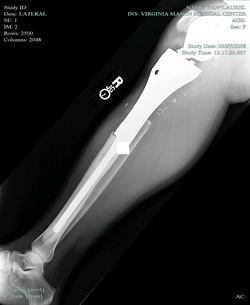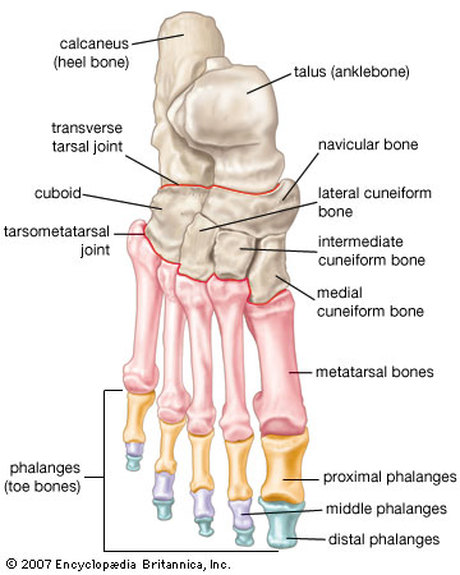The Lower Extremities

There are four parts to each lower extremity (left and right). They are: the thigh, the leg, the patella, and the foot.
The Thigh
The only bone in the thigh is the femur. It extends from the hip to the knee and is the largest and strongest bone in the body. The femur connects to the kneecap to form the knee (together with the tibia).
The Leg
The leg is made up of two bones, the tibia and the fibula. These bones extend from the knee to the foot. The fibula is located on the outside of the leg and is the smaller of the two bones in the leg. The fibula's primary purpose is muscle attachment. The tibia is on the inside of the leg and is also called the "shin" bone. It connects to the patella to form the knee, and it connects to the foot, together with the talus (anklebone) to assist with flexing and extending the foot. The tibia bears most of the weight in the leg portion of the lower extremities.
The Patella
The patella is a sesamoid bone that sits between the femur (thigh) and the tibia (leg). It helps to protect the knee joint, and also helps to strengthen the tendons in the knee.
The Foot
The foot (also called the "pes") is made up of 26 bones that are divided into three parts: the ankle (tarsus), the instep (metatarsus), and the toes (phalanges). The bones of the ankle (tarsus) includes seven tarsal bones, similar to the carpal bones in the wrist. The diagram below shows the placement and names of all seven tarsal bones. The largest of all of the tarsal bones is the calcaneous bone, which is also called the "heel." There are five metatarsal bones that make up the instep of the foot. They are numbered I-V beginning on the inside of the foot. The metatarsal bones are in the same location in the foot as the metacarpal bones in the hands. The phalanges in the foot are arranged in the same fashion as the phalanges in the hand. The diagram below shows the placement of all of the bones in the foot.
The Thigh
The only bone in the thigh is the femur. It extends from the hip to the knee and is the largest and strongest bone in the body. The femur connects to the kneecap to form the knee (together with the tibia).
The Leg
The leg is made up of two bones, the tibia and the fibula. These bones extend from the knee to the foot. The fibula is located on the outside of the leg and is the smaller of the two bones in the leg. The fibula's primary purpose is muscle attachment. The tibia is on the inside of the leg and is also called the "shin" bone. It connects to the patella to form the knee, and it connects to the foot, together with the talus (anklebone) to assist with flexing and extending the foot. The tibia bears most of the weight in the leg portion of the lower extremities.
The Patella
The patella is a sesamoid bone that sits between the femur (thigh) and the tibia (leg). It helps to protect the knee joint, and also helps to strengthen the tendons in the knee.
The Foot
The foot (also called the "pes") is made up of 26 bones that are divided into three parts: the ankle (tarsus), the instep (metatarsus), and the toes (phalanges). The bones of the ankle (tarsus) includes seven tarsal bones, similar to the carpal bones in the wrist. The diagram below shows the placement and names of all seven tarsal bones. The largest of all of the tarsal bones is the calcaneous bone, which is also called the "heel." There are five metatarsal bones that make up the instep of the foot. They are numbered I-V beginning on the inside of the foot. The metatarsal bones are in the same location in the foot as the metacarpal bones in the hands. The phalanges in the foot are arranged in the same fashion as the phalanges in the hand. The diagram below shows the placement of all of the bones in the foot.

